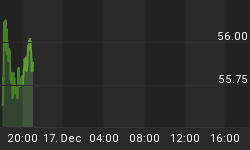The daily chart of the 10 Year US Treasury Index is shown below, with upper and lower Bollinger bands in close proximity to the current price. Full stochastics 1, 2 and 3 are shown below in order of descent, with the %K beneath the %D in all three instances. I illustrated the short-term Elliott Wave count, which clearly indicates a change of trend. This is a real trend definer, because gold does well with rising interest rates (not year over year inflation). Wave 1 lasted ~3 months and went up 1.2%. Wave 2 should last until early May correcting down to the 3.2-3.3 region. Wave 3 should be at least 1.618 fold higher in price, so 1.618 x 1.2 is equal to 1.94 (essentially 2). Tack this onto 3.2 and the TNX rates are at 5.2%. Wave 3 is likely to take 5-6 months to complete this...or late 2011/early 2012. Wave 4 should take an equivalent amount of time or till May to June. If wave 4 corrects back to 4.5%, then a 1.2% move up to have equivalency to wave 1 is 5.7% in late 2012. Wave 2 should retrace 50-61.8% of wave 1, which would see a decline back to around 3.9%. This decline will correspond to wave 2 lasting all of 2013 and into 2014 which will see declining assets prices across the board. Subsequently, waves 3, 4 and 5 to follow would put interest rates around 8-10%...at a minimum.
Figure 1
The weekly chart of the 10 Year US Treasury Index is shown below, with upper 21 and 34 MA Bollinger bands above the index, suggestive that a mid-term top was put in place. Lower 34 and 55 MA Bollinger bands aer well beneath the index, suggestive that the mid-term trend is still intact. Full stochastics 1, 2 and 3 are shown below in order of descent, with the %K above the %D in all three instances. Although a 3 month correction in wave 2 should be expected, by no means anticipate the that rising interest rates are not locked in. The mid-term trend should be up for the next 12-18 months overall.
Figure 2
The monthly chart of the TNX| is shown below, with lower Bollinger bands still well beneath the index. Full stochastics 1, 2 and 3 are shown below in order of descent, with the %K beneath the %D in 1 and above the %D in 2 and 3. The upward trend of the TNX should be on the order of 5-7 years.
Figure 3
The Elliott Wave count of the 10 Year US Treasury Index is shown below, with wave 1 shown to have recently completed. Note that I may raise the Degree of wave 1 to (1) at a later point in time if required...the present Degree of labelling at present is sufficient to illustrate the trend. The recent low back in November saw the conclusion of a contracting triangle with reverse alternation to end the 30 year decline in interest rates. Now, things to preserve wealth will be in tangible items.
Figure 4
Since I am not talking about precious metals until later this week, I thought I would provide an update on some things...
















